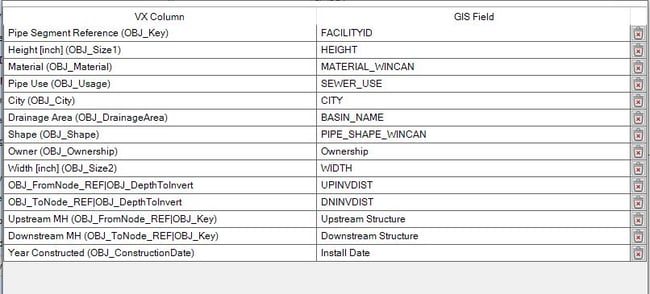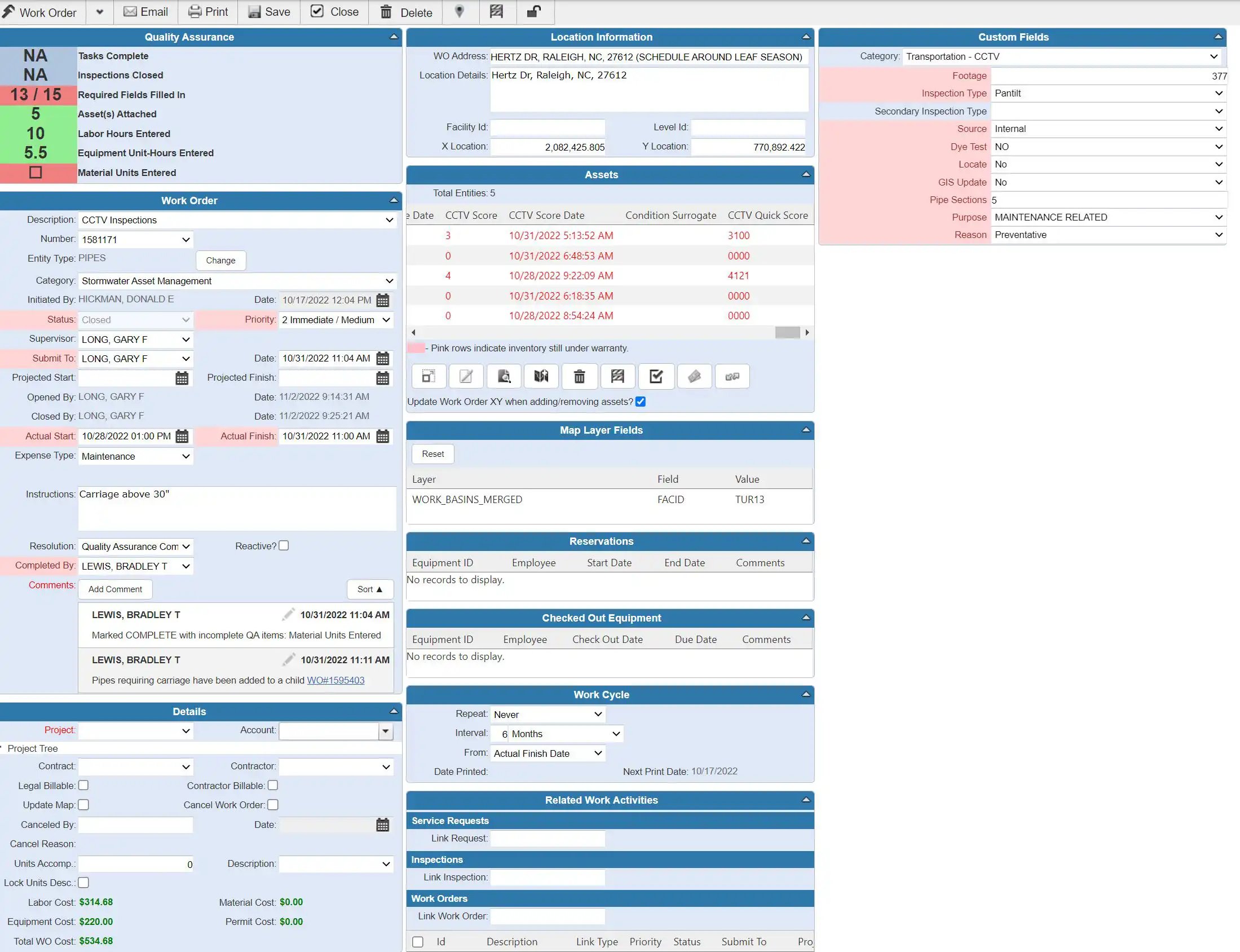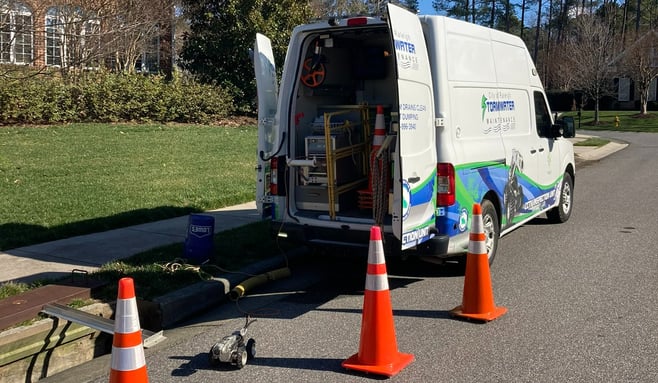Integrating software for utilities is just one way the City of Raleigh, North Carolina, is prioritizing routine infrastructure inspections and maintenance activities. The stormwater division alone oversees 35,500 storm drains and 609 miles of pipes and culverts across the city, working to monitor and protect waterways and residential areas. As demand for maintenance increases, connected, cloud-driven technology helps the city effectively manage their assets.

Raleigh stormwater team using WinCan and Cityworks side-by-side
With unpredictable weather on the rise, Raleigh closed-circuit television (CCTV) Transportation Analyst Don Hickman and Tech Supervisor Chad Foley have seen an increase in resident-submitted service requests for sinkholes and flooding. These stormwater backups and weather-induced land shifts can have a major impact on infrastructure health, shortening asset lifespans and requiring more frequent rehabilitation and inspection.
Using WinCan’s sewer inspection integration with Trimble Cityworks Asset Management Software (AMS), the Raleigh Stormwater Division has been able to simplify and automate work order creation and data ingestion, resulting in shorter customer response times and improved effectiveness and safety of public assets.
Connecting Workflows Through Integrated Solutions
As part of Raleigh’s Stormwater Asset Management Group, Don Hickman works on the front lines of CCTV inspection and pole camera program operations. He says the combination of WinCan’s inspection tools and Trimble Cityworks’ asset and inspection database was vital in developing workflows that streamline daily operations and prioritize customer calls using automation.
“We’ve been using the integration for two to three years, and we’ve seen a huge return,” says Hickman. “Data entry errors have disappeared.” The seamless flow of accurate data keeps data consistent throughout the workflow, he explains. “Mis-keying of facility IDs on pipe segment references is normally a huge problem that’s hard to catch, but by having data come directly out of GIS, through Cityworks, and into WinCan, we prevent those mistakes from happening.”
 WinCan VX data columns that are sent to Raleigh’s adjacent GIS containers
WinCan VX data columns that are sent to Raleigh’s adjacent GIS containers
Eliminating the manual steps between data collection and maintenance activities has helped create a cleaner, more accurate data set of condition grades, while also improving staff efficiencies in work order management, data entry, and much more. As workflow efficiencies increase, these time savings are passed on to customers by way of shortened response times and automated prioritization processes.
“When we started this process, only half a percent of our assets in the city were inspected,” Hickman says. “Since then, with our pole camera and crawler processes, we’ve gone from one-half of a percent to 5.5% in just two years. And with the related maintenance work to address the defects we found, that took us from 75-80% fives in our grading system to much lower condition grade.”
Hickman added that the first basin Raleigh inspected using this workflow was the oldest in the city, and the grade went from an average of 4.3 to 3.3. “It doesn't sound like a big change,” he says, “but it’s actually a huge change on a scale of 1 (best) to 5 (worst), especially in an area of the city where pipes are over 100 years old.”
 Raleigh work order viewed in Cityworks before it’s sent into WinCan
Raleigh work order viewed in Cityworks before it’s sent into WinCan
Streamlining Data with Integrated Software
The City of Raleigh’s use of integrated software helps make asset information easily accessible by breaking down data silos between teams. Team members are able to retrieve and update asset data, ensuring that they have a clear picture of the health, location, and maintenance history of their public infrastructure. Providing team members with consistent access to reliable data allows the city to build public trust by better serving the community.
In particular, Hickman praises WinCan’s ability to sort through data with the user filters. “I couldn’t imagine trying to look through our database,” he says. “We have 4,700 pipes in our master database; it’s a big dataset and it’s going to keep growing. But being able to layer inspections on top of each other is great. I can see it year over year right in the same spot.”
Tech Supervisor Chad Foley also highlights the benefits of using Trimble Cityworks to consolidate actionable data and perform inspections.
“Cityworks is designed to bring data in and link it together.” says Foley. “That’s why we are using it heavily in our pole camera program. Cityworks gives us the ability to attach videos and images that help team members quickly identify problems, so they can efficiently make repairs or take other necessary action .”
From an IT standpoint, Foley says the integration between Cityworks and WinCan is just one piece of a much larger web of municipal software automations that Raleigh is using to improve efficiency and collaboration across the city’s public works teams, with Cityworks at the center of the web for asset management and maintenance.
Automating Inspection and Asset Management Activities
Raleigh’s stormwater inspection workflow relies on three key solutions to achieve success: WinCan’s inspection platform, Esri ArcGIS® , and Cityworks AMS, along with Cityworks Operational Insights. The interactions between these solutions triggers notifications and other actions, such as the creation of inspection work orders whenever repair or flushing work orders are closed.
“Work orders are generated in Cityworks with all of the required assets attached and submitted to the inspection unit,” says Hickman. “ When the inspection team members get to that job, they open up WinCan and use the integration import to bring over all the associated assets, creating the inspection. It brings in all the fields we have mapped in Cityworks, which is facility ID, upstream and downstream nodes, material, rim elevations, age, shape, and ownership.”
With the necessary asset data logged, Hickman’s team can carry out the inspections as usual, using two of Envirosight’s ROVVER X crawlers and five Quickview AirHD zoom cameras to collect data.
“Our pole camera program pushes a lot of data,” says Hickman, who has helped streamline pole camera inspections from Cityworks directly into ArcGIS Online. However, crawler inspections need to pass through WinCan, where results can be validated before transferring to a GIS database. “An automation runs from WinCan to ArcGIS overnight that writes three specific things: the structural code, the date when it was coded, and whatever the highest graded defect was. It writes those into GIS directly onto the schema for that asset.”
At this point, the process can begin anew, with asset data being pulled into Cityworks for work order creation once again. This integrated approach to inspections and public asset management significantly reduces the time it takes to identify high-risk areas. In addition, these seamless workflows are helping the field crews address and cut down on resident sinkhole and flooding complaints, helping to ensure that the community is safe and sustainable.

Raleigh stormwater inspection truck on the job
Saving Time for Field Crews and Customers
Foley sees the data automation as essential in planning and executing maintenance work and coordinating with other departments.
“WinCan and Cityworks are the source for our priority model,” says Foley. “All the WinCan scoring that’s happening is feeding ArcGIS, which Cityworks Operational Insights is consuming. With that, we run quarterly probability failure, time consequence failure, business risk exposure, and get that prioritization for future work.”
This process has allowed the City of Raleigh to be proactive in its approach to stormwater maintenance trends, enabling them to detect and address infrastructure failures as early as possible to minimize disruptions for customers. Foley says Raleigh has even been able to use customer support calls to populate alerts in ArcGIS to help allocate repair funds to the public for emergency needs, further bolstering support to residents affected by flooding.
“Customer calls that come in as drainage complaints automatically create a point in ArcGIS Online that eventually become a work order,” he says. “The city’s stormwater division puts aside a bucket of money for remediation of certain types of drainage complaints. These funds essentially become financial assistance for citizens in need in an emergency or crisis situation.”
With Hickman and Foley’s guidance, the City of Raleigh’s stormwater team has been able to synchronize efforts with IT to improve infrastructure condition, streamline data and workflows, reduce response time to residents, and ensure that service requests are effectively addressed. The joint use and integration of Trimble Cityworks and WinCan solutions is a clear catalyst for the many improvements in asset management outcomes that the City of Raleigh is seeing.
“We’re saving money by saving time,” says Hickman. “And we’re delivering more productivity and less waste.”
Promoting safety, efficiency, and sustainability in your community starts by protecting infrastructure. Get in touch with the WinCan team to learn more about how your inspection team can integrate with asset management and beyond:





